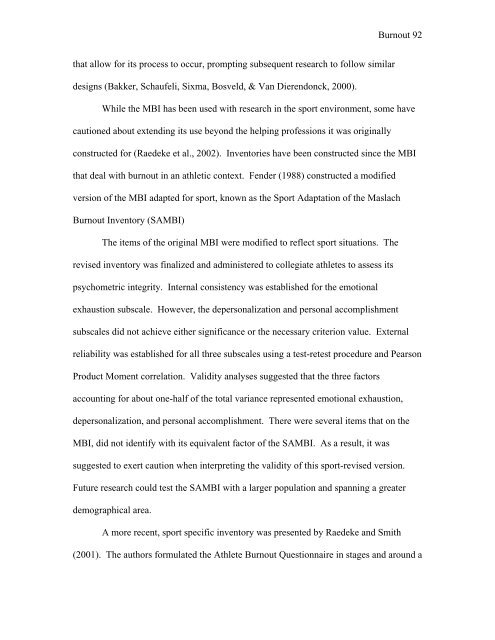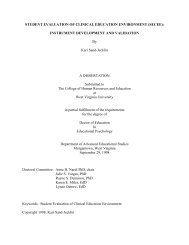Coach and Athlete Burnout - West Virginia University
Coach and Athlete Burnout - West Virginia University
Coach and Athlete Burnout - West Virginia University
You also want an ePaper? Increase the reach of your titles
YUMPU automatically turns print PDFs into web optimized ePapers that Google loves.
that allow for its process to occur, prompting subsequent research to follow similar<br />
designs (Bakker, Schaufeli, Sixma, Bosveld, & Van Dierendonck, 2000).<br />
<strong>Burnout</strong> 92<br />
While the MBI has been used with research in the sport environment, some have<br />
cautioned about extending its use beyond the helping professions it was originally<br />
constructed for (Raedeke et al., 2002). Inventories have been constructed since the MBI<br />
that deal with burnout in an athletic context. Fender (1988) constructed a modified<br />
version of the MBI adapted for sport, known as the Sport Adaptation of the Maslach<br />
<strong>Burnout</strong> Inventory (SAMBI)<br />
The items of the original MBI were modified to reflect sport situations. The<br />
revised inventory was finalized <strong>and</strong> administered to collegiate athletes to assess its<br />
psychometric integrity. Internal consistency was established for the emotional<br />
exhaustion subscale. However, the depersonalization <strong>and</strong> personal accomplishment<br />
subscales did not achieve either significance or the necessary criterion value. External<br />
reliability was established for all three subscales using a test-retest procedure <strong>and</strong> Pearson<br />
Product Moment correlation. Validity analyses suggested that the three factors<br />
accounting for about one-half of the total variance represented emotional exhaustion,<br />
depersonalization, <strong>and</strong> personal accomplishment. There were several items that on the<br />
MBI, did not identify with its equivalent factor of the SAMBI. As a result, it was<br />
suggested to exert caution when interpreting the validity of this sport-revised version.<br />
Future research could test the SAMBI with a larger population <strong>and</strong> spanning a greater<br />
demographical area.<br />
A more recent, sport specific inventory was presented by Raedeke <strong>and</strong> Smith<br />
(2001). The authors formulated the <strong>Athlete</strong> <strong>Burnout</strong> Questionnaire in stages <strong>and</strong> around a












